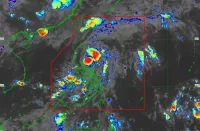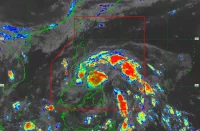QUEZON City, Philippines (October 16) – “Yaya, can you buy this in the palengke?”
“Are you going to eat the ulam”
“He says parang it’s not complete daw tapos he’s not okay with it daw.”
I bet you already guessed what these sentences are. And yes, you’re right!
Its’s taglish!
 Our friend, the Wikipedia says Taglish, or Englog, is code-switching between English and Tagalog, the common languages of the Philippines, that developed in Manila. There are attempts to differentiate the usage of the words “Taglish” and “Englog”, where Taglish refers to the usage of English words in Tagalog syntax and Englog refers to the usage of Tagalog words in English syntax.
Our friend, the Wikipedia says Taglish, or Englog, is code-switching between English and Tagalog, the common languages of the Philippines, that developed in Manila. There are attempts to differentiate the usage of the words “Taglish” and “Englog”, where Taglish refers to the usage of English words in Tagalog syntax and Englog refers to the usage of Tagalog words in English syntax.
Taglish and Englog are used by Filipinos in countries like Australia, Canada, the Republic of Ireland, New Zealand, the United States, and the United Kingdom. It is used in text messages to write more quickly.
Taglish nowadays are very common especially among teenagers and adults. If one is working in a business company or a student in a private school, chances are taglish is their form of communication.
Lea Cabotaje said in her blog that Conyo is a term used to describe people who speak annoying tone using the Carabao English. However, it is a spirit-lifting and a laughable matter hearing people who talk conyo in a funny way. This kind of language is the newest meme disease nowadays. Teenagers, like us, commonly do this way of communicating.
In universities, there are many people that can be identified as conyos. There are the rich ones, social climbers and also people who just mock other persons. You can also find conyos on the street roads and malls. In the streets, “tambays” are always there. Sometimes they speak Taglish not knowing that they do it in a conyo way. With so many conyos around us, don’t even wonder if , pedicab drivers and other street people will also speak with this kind of language. Kind of silly right? Imagine how cigarette vendors speak conyo: “Hey! Cigarettes for sale! May libreng candy!”
Do you know when did conyo people became well.. conyo?
According to the blog of soyprinsipe, The first theory is, in the mid 60’s, when the custodians/nannies (also called yáyas) of the wealthy families were obliged to speak in English especially to the child/children they were taking care of. Since majority of the nannies lacked education, and couldn’t speak straight English, they blend English with Tagalog. The children, instead learning straight English, learned how to blend the two languages. While they were growing up, they were used to blend these to languages.
The second theory is, in the 1970’s to 1980’s, when English became so predominant in the Philippines that it became compulsory especially for the students to speak English in schools, universities and other educational institutions. Those upper class people particularly the ”colegialas” used to speak Taglish because they thought that they became more sociable when speaking it. And for this generation, Taglish has become a lingua franca (a language used as a common language between speakers whose native language are different) by those people who can’t speak straight English.
The media also played an important role of spreading this newly-formed language. By the 1980’s, Taglish was spoken by a number of host and local artist, especially Dina Bonnevie, Pops Fernandez, Sharon Cuneta, in talk shows, drama series, movies that made the audience accept it. By the 1990’s, Taglish became widespread and used almost by the majority.
After the arrival of the new millennium, Taglish has almost become the most-used way of speech especially in Metro Manila, hence some native words has largely disappeared and placed by the English ones. For example, a particular Filipino student would prefer to use the word “page” rather than the native word “pahina”, “takdang-aralin” was replaced by “assignment”, “proyekto” was placed by the word “project”, so he/she would say “Ginawa mo na ba ang assignment mo?” instead of saying “Ginawa mo na ba ang takdang aralin mo?” and hundreds of native words were placed by the English ones. At the present time, Kris Aquino is the Taglish Queen of the Philippines since she blends almost each word in Tagálog and English alternately on all interviews and shows that she had.
Due to the birth of Taglish, new Tagalog words were also born derived from the English translations. For example the word “bolpen” from “ballpen”, but the native word for this is “panulat”, “kantin” from the word “canteen”, “klinik” from the word “clinic”, instead of saying “klinika”.
Right now, taglish can be heard everywhere. If you are to be asked, what language do you use?
English, Filipino?
Taglish perhaps?
(written by Joana Joyce Tan Marcaida, edited by Jay Paul Carlos, additional research by Lovely Ann Cruz)








